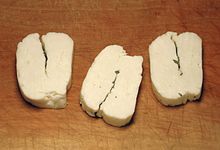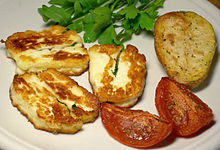Halloumi
Halloumi or Challúmi ( Greek Χαλλούμι ; Turkish Hellim; often just referred to as Halumi ) is a semi-solid cheese made from the milk of cows , sheep or goats , also mixed. Halloumi is often referred to as “grilled cheese”.
General
Halloumi, an ancient Egyptian form of cheese preparation, is a specialty of some Mediterranean countries , where the cheese has been made for over 2000 years, originally from the milk of mouflons . Today's cheese, which is mainly made from sheep's milk , is similar to mozzarella , but is firmer and spicier. Unlike most other cheeses, it retains its shape when heated.
Fried or grilled halloumi with homemade french fries is a standard dish in many restaurants in Cyprus. With a fried egg , it is part of the Cypriot breakfast. Halloumi omelets and ravioli filled with halloumi are also common . It is served fresh with watermelons or as a filling in fresh dates . A little dried it can be used as grated cheese.
origin
It is believed to have originated in the cuisine of ancient Egypt and is now known in many countries, including Greece , Turkey , Israel , Lebanon , Egypt and Libya . Halloumi was first mentioned in Ottoman sources in the 16th century.
etymology
The oldest mention in Cyprus comes from the 16th century, in a text by Leonardo Dona from 1556 he is referred to as Calumi . The origin of the term has not been clarified beyond doubt; a derivation from the ancient Greek term ἅλμη or from the ancient Egyptian and Coptic ialom appears possible . The term is also used in Turkish with hellim and in Arabic with Arabic حلوم, DMG Ḥallūm found.
For a long time the cheese was only referred to as grilled cheese in export to indicate this property. In the meantime, the halloumi has become more popular.
The common spelling "Halloumi" is of British origin. The British brought the recipe from Cyprus to Australia during colonial times , where the cheese is still made today.
Manufacturing
To make halloumi, fresh milk and cream are warmed to body temperature, rennet and salt mixed with water are added, the resulting layer of cheese is carefully broken up after about three quarters of an hour and everything is briefly heated again. Then the whey is poured off through a sieve, the cheese mass is squeezed out forcefully, shaped into squares as thick as a finger and left to rest for a while. Finally, the cheese is boiled in the whey for about ten minutes, removed, sprinkled with salt and mostly mint on one side , folded once and squeezed, which gives it its typical shape.
Anarí , a cream cheese reminiscent of cottage cheese , can also be made in the halloumi whey . To do this, before the halloumi is cooked, milk and lemon juice are added to the hot whey and stirred until it curdles. After draining, the resulting mass is used for pies , desserts and the like.
Industrially produced halloumi is available in Germany in most supermarket chains, Jewish kosher shops and in Turkish, Greek and Arab grocery stores.
Trivia
On July 31, 2020, 37 members of the Cypriot parliament voted against the CETA agreement between the EU and Canada, as they did not see the Cypriot halloumi cheese adequately protected in it. The ratification of the agreement by Cyprus is still pending.
literature
- Lenia and Barnim Heiderich: Cooking Cypriot . Edition diá, Berlin 1992. ISBN 3-905482-65-7
Web links
Individual evidence
- ↑ Claudia Lucero: Make your own cheese in just 1 hour: cream cheese, ricotta, halloumi, burrata, 2015
- ↑ Juliet Harbutt, et al .: Cheese of the World - over 750 types. Dorling Kindersley, Munich 2011, ISBN 978-3-8310-1733-1 , p. 278
- ↑ Cyprus national cheese halloumi. In: Cyprus Times. September 16, 2011, accessed March 14, 2014 .
- ↑ βλ. [1]
- ↑ Cyprus blocks CETA trade agreement because of halloumi cheese. In: Frankfurter Allgemeine Zeitung. August 3, 2020, accessed August 4, 2020 .

